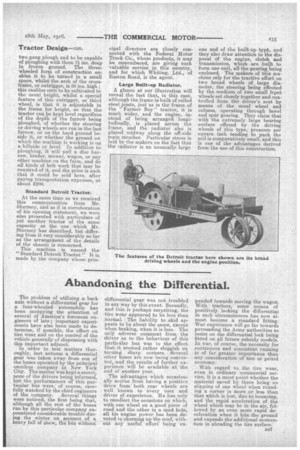Abandoning the Differential.
Page 13

If you've noticed an error in this article please click here to report it so we can fix it.
The problem of utilizing a back axle without a differential gear for a four-wheeled automobile has been occupying the attention of several of America's foremost engineers of late ; important experiments have also been made to determine, if possible, the effect on tire wear and on the control of the vehicle generally of dispensing with this important adjunct.
In order to test matters thoroughly, last autumn a differential gear was taken away from one of the buses operated by the principal omnibus company an New York City. The matter was kept a secret, none of the drivers being informed, but the performances of this particular bus were; of course, carefully watched by the chief engineers of the company. Several things were noticed, the first being that, although all the rest of the buses run by this particular company encountered considerable trouble during the winter, on account of, a heavy fall of Snow, the bus without differential gear was not troubled in any way by this event. Secondly, and this is perhaps surprising, the tire wear appeared to be less than normal. The liability to .skid appears to be about the same, except when braking, when it is less. The only adverse comment from the driver as to the behaviour of this particular bus was to the effect that it seemed rather sluggish on turning sharp corners. Several other buses are now being converted, and the results of further experience will be available at the end of another year.
The advantages which occasionally accrue from having a positive drive from both rear wheels are well known to every user and driver of experience. He has only to recollect the occasions on which, with one wheel on a good piece of road and the 'other in a mud hole, all his engine power has been tievoted to churning up the mud, without any 'useful 'effort being ex
pended towards moving the wagon. With tractors, some means of positively locking the differential in such circumstances has now almost become a standard fitting. War experience will go far towards persuading the Army authorities to insist on the differential lock being fitted on all future subsidy models. In war, of course, the necessity for continuous and consistent running is of far greater importance than any consideration of tire or petrol economy.
With regard to the tire wear, even in ordinary commercial service, it is a moot point whether the material saved by there being no slipping of one wheel when rounding a corner is more or less than that which is lost, due to bouncing, and the rapid acceleration of the wheel which may be in the air, followed by an even more rapid deceleration when it hits the ground and expends the additional momentum in abrading the tire surface.




















